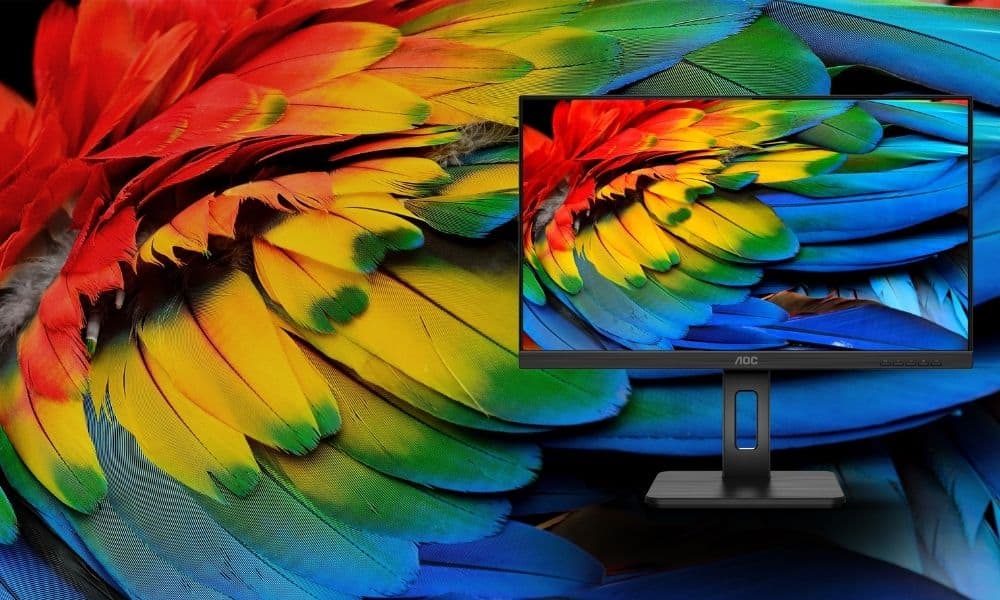Color gamut is a very important aspect of a monitor’s performance. Specifically, it speaks to a monitor’s entire color range. With humans having the ability to see between 2 and 10 million colors, an expansive range can work wonders in transforming how we work and play with the latest computer monitors.
What is Color Gamut on Monitors?
Color gamut refers to the full range of colors a human eye could use when viewing a monitor. You’ll be able to tell somewhat, especially if your monitor is one of the best displays for watching movies. Consider it a collection of different colors with varying hue, saturation, and brightness levels. One of the more popular color gamuts used by monitors is sRGB, which uses red, green, and blue as a base color to generate and project millions of color shades. It’s more detailed than the monitor contrast ratio.
AdobeRGB is another type of color gamut, a more enhanced version of sRGB used by design professionals for photos and print. It offers a better translation and a wider range of colors. This is very different than a monitor color accuracy test.
On a lesser scale, NTSC is a more restricted color gamut that is based on the television’s standard, limited to actual colors that can be discerned by the human eye.
Warning: NTSC is a more restricted color gamut that is based on the television’s standard
Other lesser-known color gamuts available to the public is the DCI-P3 color space (popular with digital cinema with backing by The Society of Motion Pictures and Television Engineers, and EBU, which was invented by the European Broadcasting Union for video platforms.
- Related Post: Which Monitor Panel Types are the Best?
- Related Post: How to Know Which Display Size is Best for You
What is a Color Gamut Rating?
Not all monitors represent each color gamut to its full potential. For example, one monitor can be rated at 92% of sRGB and another monitor can be rated at 100% Adobe RGB, making the latter the superior monitor. On average, expect 70 to 75 percent of NTSC coverage. Note, color gamuts are influenced by the quality and type of backlighting used in monitors. Some backlighting is more efficient than others. Many are even capable of producing a color gamut greater than 100 percent. Combined with an impressive refresh rate, you’ll have a high-performing monitor.
Warning: Note, color gamuts are influenced by the quality and type of backlighting used in monitors
What are Color Gamut Standards?
For professional quality image reproduction, look for monitors with a wide gamut between 92 to 100 percent of NTSC.
- Related Post: What is an LCD Monitor?
- Related Post: What are the Different Monitor Types?
STAT:
According to Eizo.com, the sRGB color gamut covers about 72% of the NTSC gamut.
Sources:
https://www.benq.com/en-us/knowledge-center/knowledge/color-gamut-monitor.html
https://www.rtings.com/monitor/tests/picture-quality/color-gamut
https://www.lifewire.com/lcd-monitors-and-color-gamuts-833038
https://www.bhphotovideo.com/explora/amp/computers/hands-on-review/5-top-monitor-features-for-creative-professionals




































![Best 27 Inch Computer Monitor in [year] 27 Best 27 Inch Computer Monitor in 2026](https://www.gadgetreview.dev/wp-content/uploads/how-to-buy-the-best-computer-monitor.jpg)
![Best BenQ Monitors in [year] 28 Best BenQ Monitors in 2026](https://www.gadgetreview.dev/wp-content/uploads/best-benq-monitor-image.jpg)
![Best ASUS Monitors in [year] 29 Best ASUS Monitors in 2026](https://www.gadgetreview.dev/wp-content/uploads/best-asus-monitor-image.jpg)
![Best Dell Monitors in [year] 30 Best Dell Monitors in 2026](https://www.gadgetreview.dev/wp-content/uploads/best-dell-monitor-image.jpg)
![Best HP Monitors in [year] 31 Best HP Monitors in 2026](https://www.gadgetreview.dev/wp-content/uploads/best-hp-monitor-image.jpg)
![Best Lenovo Monitors in [year] 32 Best Lenovo Monitors in 2026](https://www.gadgetreview.dev/wp-content/uploads/best-lenovo-monitor-image.jpg)
![Best ViewSonic Monitors in [year] 33 Best ViewSonic Monitors in 2026](https://www.gadgetreview.dev/wp-content/uploads/best-viewsonic-monitor-image.jpg)
![Best Gigabyte Monitors in [year] 34 Best Gigabyte Monitors in 2026](https://www.gadgetreview.dev/wp-content/uploads/best-gigabyte-monitor-image.jpg)
![Best Monitors for PS4 Pro Gaming in [year] 35 Best Monitors for PS4 Pro Gaming in 2026](https://www.gadgetreview.dev/wp-content/uploads/best-monitors-for-ps4-pro-image.jpg)
![Best Monitor for Xbox Series X in [year] 36 Best Monitor for Xbox Series X in 2026](https://www.gadgetreview.dev/wp-content/uploads/best-monitor-for-xbox-series-x-image.jpg)
![Best Acer Monitors in [year] 37 Best Acer Monitors in 2026](https://www.gadgetreview.dev/wp-content/uploads/best-acer-monitor-image.jpg)
![Best MSI Monitors in [year] 38 Best MSI Monitors in 2026](https://www.gadgetreview.dev/wp-content/uploads/best-msi-monitor-image.jpg)
![Best SAMSUNG Monitors in [year] 39 Best SAMSUNG Monitors in 2026](https://www.gadgetreview.dev/wp-content/uploads/best-samsung-monitor-image.jpg)
![Best LG Monitors in [year] 40 Best LG Monitors in 2026](https://www.gadgetreview.dev/wp-content/uploads/best-lg-monitor-image.jpg)
![Best AOC Monitors in [year] 41 Best AOC Monitors in 2026](https://www.gadgetreview.dev/wp-content/uploads/best-aoc-monitor-image.jpg)
![Best Philips Monitors in [year] 42 Best Philips Monitors in 2026](https://www.gadgetreview.dev/wp-content/uploads/best-philips-monitors-image.jpg)
![Best Monitors For PUBG in [year] 43 Best Monitors For PUBG in 2026](https://www.gadgetreview.dev/wp-content/uploads/best-monitor-for-pubg-image.jpg)
![Best Stream Decks in [year] 44 Best Stream Decks in 2026](https://www.gadgetreview.dev/wp-content/uploads/best-stream-deck-image.jpg)
![Best Monitors for Streaming in [year] 45 Best Monitors for Streaming in 2026](https://www.gadgetreview.dev/wp-content/uploads/best-monitor-for-streaming-image.jpg)
![Best Monitors For Flight Simulator in [year] 46 Best Monitors For Flight Simulator in 2026](https://www.gadgetreview.dev/wp-content/uploads/best-monitor-for-flight-simulator-image.jpg)




















